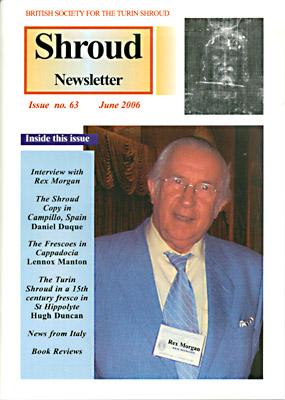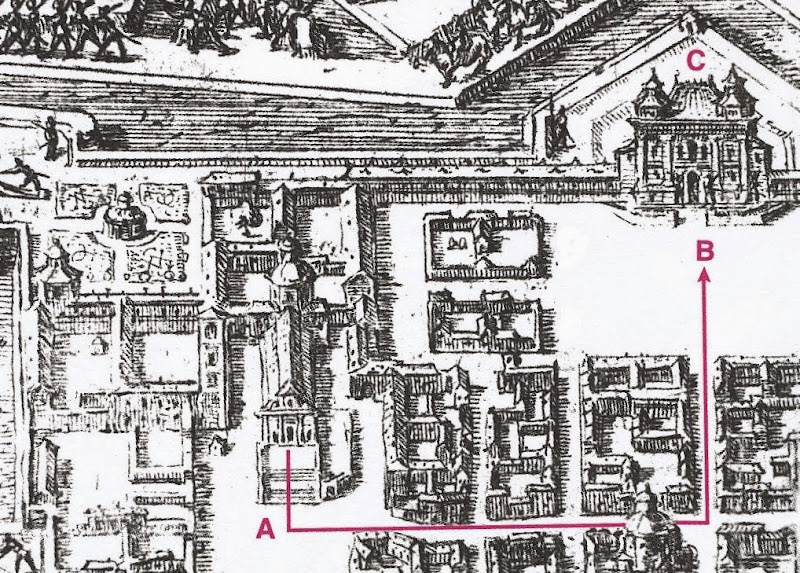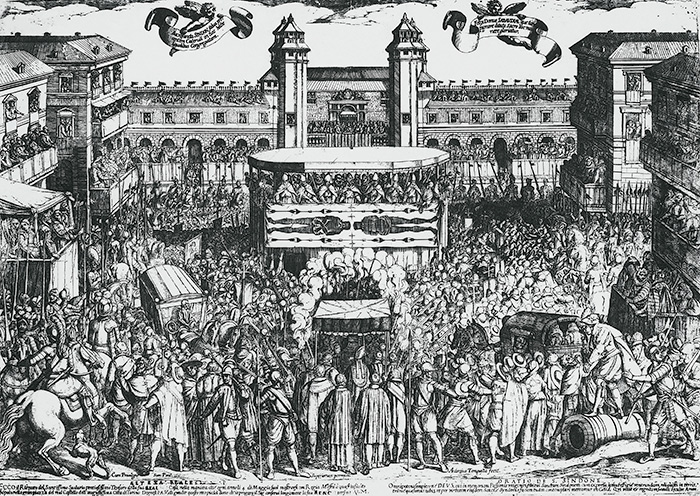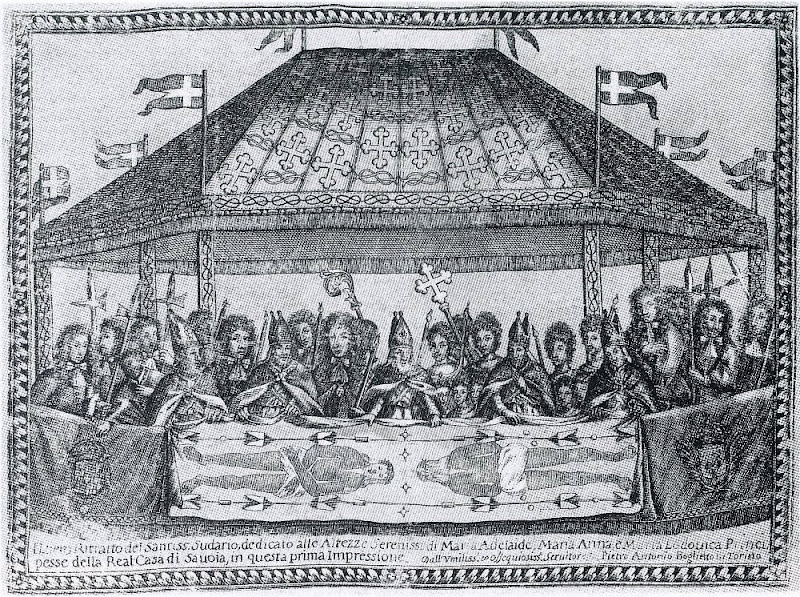Introduction. This is part #10, Summary (8), of my theory that the radiocarbon dating laboratories were duped by a computer hacker. My next post in this series will be part #10(9). See the previous parts #10(1), #10(2), #10(3), #10(4), #10(5), #10(6) and #10(7). Other previous posts in this series were parts #1, #2, #3, #4, #5, #6, #7, #8 and #9, which posts this part #10 will summarise. It is my emphasis below unless otherwise indicated.
[Index [#2] [#3][#4][#5][#6][#7][#8][#9][#10(1)][#10(2)][#10(3)][#10(4)][#10(5)][#10(6)][#10(7)][#10(9)][#10(10)].]
[Above: Arizona radiocarbon dating laboratory's AMS (Accelerator Mass Spectrometry) control console computer terminal[2] just before, or just after, it had on 6 May 1988 displayed the alleged hacker's bogus radiocarbon age of the Shroud, "640 years"[3], which was then calibrated to "1350 AD"[4]. Dr. (now Prof.) Timothy Jull is in the green jumper, and the alleged hacker, Timothy W. Linick, is in the black shirt[5].]
8. RESPONSES BY PROFESSORS JULL AND RAMSEY ARE EVIDENCE THAT TIMOTHY W. LINICK WAS THE HACKER [#7]
• The AMS computer at Arizona was a "DEC computer system." In the previously cited 1986 Radiocarbon paper Linick stated that Arizona's AMS computer was a "DEC computer system" which "largely controls the ... calculation of results for each 15-minute run":
"The DEC computer system largely controls the cycling of isotopes, accumulation of data, and calculation of results for each 15-minute run"[6]
This is consistent with the terminal in the photo above, from page 176H of Prof. Harry Gove's book, which appears to be a DEC VT-100 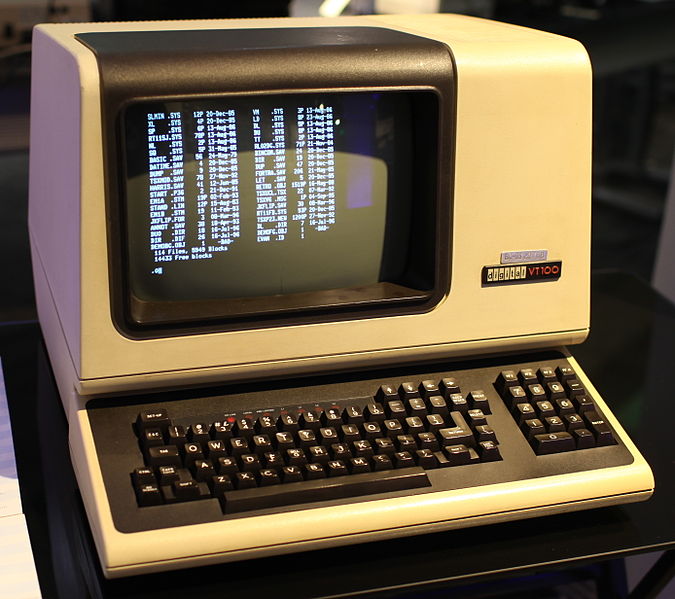 , which were typically networked
, which were typically networked
[Right (enlarge): A DEC VT-100 terminal[7].]
to a DEC minicomputer (i.e. a mini-mainframe-computer). "DEC" stands for Digital Equipment Corporation, the maker of the powerful PDP-11 and VAX-11 mini- computers which were popular in science laboratories in the 1980s.
• Arizona's Prof. Jull's misleading and even false response to my hacking proposal. A copy of a comment I made when I was on Dan Porter's blog, proposing that the radiocarbon dating laboratories may have been duped by a computer hacker (at that early stage I did not claim it was a theory) was sent without my permission to Prof. A.J. Timothy Jull, Director of the Arizona radiocarbon dating laboratory.
[Left: Prof. A.J.T. Jull: Hungarian Academy of Sciences[8]. Prof. Jull was a signatory to the 1989 Nature paper[9] and is in Prof. Gove's photo above of those present at Arizona's first dating of the Shroud.]
and to Oxford's Prof. Christopher Ramsey, by the anti-authenticist Editor of the BSTS Newsletter, Hugh Farey[10]. Both Profs. Jull and Ramsey, surprisingly replied, and Porter posted those replies to his blog[11].
Prof. Jull's reply to Farey (as copied to my blog [12]) was as follows:
"This is impossible. In our case, the software for the calculations is offline. In any case, the calculation does NOT require software, it was done offline and plotted on a graph, as I recall. Indeed, in 1988 the internet (as we know it today) didn't exist – there was a pre-existing network run by the US government which was quite restricted. Anyway, the machine we used at that time couldn't have been attached to it, and that one still isn't."
First I was (and still am) amazed that two Professors, who are Directors of major radiocarbon laboratories, would bother responding to anonymous (Farey said he did not give them my name) blog comments. That itself is evidence that they may have been aware, following Linick's `suicide', that their laboratories' AMS computers may have been hacked by Linick in the 1988 carbon dating of the Shroud.
I don't know what Farey prefaced my comments with, but as I pointed out in my response when I was on Porter's blog (copied to my blog[13]), I said nothing about "the Internet" and Prof. Jull's "the software for the calculations is offline ... the calculation does NOT require software, it was done offline and plotted on a graph" (his emphasis) is not only self-contradictory (if the "calculation does NOT require software," why is "the software for the calculations ... offline"?), it is misleading, and even false. As we saw above, in a 1996 Radiocarbon journal paper, the first author of which was "T.W. Linick" and its second author, "A.J.T. Jull" (see reference [6] below), while the final calibration was "done offline and plotted on a graph," as I did in part #5, the actual "calculation of results for each 15-minute run" was done by the "DEC computer system."
This was confirmed by Prof. Gove’s eyewitness account of Arizona's first Shroud dating run, published in 1986:
"The first sample run was OX1 [an oxalic acid control]. Then followed one of the controls. Each run consisted of a 10 second measurement of the carbon-13 current and a 50 second measurement of the carbon-14 counts. This is repeated nine more times and an average carbon-14/carbon-13 ratio calculated. All this was under computer control and the calculations produced by the computer were displayed on a cathode ray screen"[14].and by David Sox’s 1988 account, presumably obtained from Gove, since Sox wasn't there:
"The calculations were produced on the computer, and displayed on the screen. Even the dendrochronological correction [the calibration] was immediately available. All eyes were on the screen. The date would be when the flax used for the linen relic was harvested."[15]
Prof. Jull must have known this, so his reply to Farey that "the software for the calculations is offline ... the calculation does NOT require software, it was done offline and plotted on a graph" (his emphasis) is not only self-contradictory, but misleading and false.
However, from Prof. Ramsey's reply (see next) where he wrote, "Age calculation was done offline ...," I will charitably assume that by "calculations," Prof. Jull was referring not to the computer's calculation that Gove and Sox wrote about, but to the "offline" further processing, including calibration, of those computer calculations. If so, then while what Prof. Jull wrote in his reply above would not be deliberately false, it would still be difficult not to conclude that Jull was being deliberately misleading. That is because Prof. Jull must have known that it was "the calculations produced by the computer" which I was alleging had been hacked, not the further processing "offline" of those computer "calculations."
In which case this would itself be further evidence for my theory that the the radiocarbon laboratories were duped by a computer hacker (allegedly Timothy W. Linick). That is, following Linick's `suicide' on 4 June 1989, a little over three months after the 16 February 1989 Nature paper which claimed that the Shroud was "mediaeval ... AD 1260-1390"[16] appeared, Arizona laboratory leaders (of which Prof. Jull was not then among) may have discovered evidence that Linick had hacked Arizona's dating. If so, they would presumably not have been able to explain how Linick could have also hacked Zurich's and Oxford's datings. Which would in turn explain why Jull (and Ramsey-see next) emphasised that none of the three laboratories' AMS computers were online via "the Internet," which I hadn't mentioned. In which case the laboratories may have assumed that the Shroud was medieval after all and Linick's hacking of Arizona's dating made no difference to the final result. What other explanation is there for Prof. Jull's (and Prof. Ramsey's - see next) strange defensiveness, replying (and promptly at that) to an anonymous blogger's comments, misleadingly referring to "calculations ... offline," which are clearly irrelevant to my hacker claim, and going on at length about "the Internet" which I said nothing about?
• Oxford's Prof. Ramsey's misleading and even false response to my hacking proposal. My surprise that Prof. Jull had responded to an anonymous (to him) comment of mine on Dan Porter's blog turned to amazement when my further reading of those comments revealed that the Director of the Oxford radiocarbon dating 
[Right: Prof. Christopher Bronk Ramsey[17, 18], who as "C.R. Bronk" (for his original name Christopher Ramsey Bronk[19]) was also one of the signatories to the 1989 Nature paper[20].]
laboratory, Prof. Christopher Ramsey, had also responded to my comment sent to him by Farey, as follows:
"Yes – I agree with all that Tim [Jull] says. This would seem to be a suggestion from someone who does not know what computers were like in the 1980s. In the case of Oxford the AMS had no connection to any network (and indeed even today our AMS control computers have no network connections). The software was very simple just outputting counts of 14C and currents measured. Age calculation was done offline and could just be done with a calculator, or by a simple program into which you typed the numbers from the AMS"[21]
The first question is, how did Ramsey know "all that Tim [Jull] says"? Did Farey, having received Jull's response, email it to Ramsey for his added response? Or did Farey send my comments to both Jull and Ramsey separately at the same time and one of them contacted the other to present a united front?
Ramsey states that he agrees "with all that Tim [Jull] says," despite Jull's "...the software for the calculations is offline. ... the calculation does NOT require software" being at least self-contradictory and misleading (see above).
Like Jull, Ramsey also strangely (if not suspiciously) downplayed the role of the AMS computer. Indeed some on Porter's blog (including Porter himself) took Prof. Ramsey to be claiming that the AMS computer was little better than a calculator, and Porter even questioned whether it was "programmable"! When, as we have seen, both Jull and Ramsey knew that it was a "DEC computer system," probably either a PDP-11 [right][22], or more likely a VAX-11 [below left][23], both of which were powerful, programmable, and therefore hackable computers! In fact as we shall see in part #10(9), some versions of VMS, the operating system of PDP/VAX computers, had a bug which made them vulnerable to hacking, and in fact were hacked.
Moreover, in his reply above, Prof. Ramsey's "This would seem to be a suggestion from someone who does not know what computers were like in the 1980s" is not only false, it is again difficult not to conclude that it is deliberately false, given that Ramsey, like Jull, knew that the AMS computer was a very powerful "DEC computer system." In fact, as I pointed out in my reply to Ramsey's response on Porter's blog, copied to my blog[24], far from me being "someone who does not know what computers were like in the 1980s":
"I was one of the first to have a personal computer in 1980. I pioneered the introduction of computers into Health Department of WA [Western Australia] hospitals in the mid-to late 1980s and in the late 1980s/early 1990s, I was the Systems Administrator of a network of 7 hospitals' UNIX systems."
Prof. Ramsey's ad hominem response cannot be explained by a lack of computer literacy, since he is the author of OxCal, a radiocarbon dating calibration computer program[25]. So, knowing that the AMS computers at the three laboratories were very powerful DEC minicomputers, what was Ramsey's point in claiming, falsely, that I was "someone who does not know what computers were like in the 1980s"? It is difficult not to conclude that Prof. Ramsey was deliberately trying to hide the fact that the AMS computers were indeed hackable. Which would be further evidence that after Linick's `suicide,' Arizona laboratory may have discovered evidence that its AMS computer, and hence its dating, had been hacked.
Prof. Ramsey's "The software was very simple just outputting counts of 14C and currents measured" confirms my key point that there was "software" between the Shroud samples and the "outputting counts of 14C" displayed on the AMS computer's control console terminal. And being "software" it was hackable. That the "software was very simple" is irrelevant, so why mention it? Again Prof. Ramsey's defensiveness suggests that he has something to hide.
As we saw above Prof. Ramsey's "Age calculation was done offline" clarified what Prof. Jull probably meant by "calculation." But as with Jull, it is irrelevant that the "counts of 14C" were further processed "offline". Prof. Ramsey, like Prof. Jull, must be highly intelligent, and so they would surely know that if there was a hacking it would be in those "counts of 14C" before they were further processed offline. Indeed, Prof. Ramsey's "...a simple program into which you typed the numbers from the AMS," tacitly admits that the "numbers from the AMS" are from which the dating follows. If the Shroud samples' "numbers from the AMS" had been hacked, the further offline processing would inevitably reflect that hacked dating.
Nevertheless I did accept Profs. Jull and Ramsey's assurance that the AMS computers at Arizona and Oxford (and presumably also at Zurich) were never online. This however was not a problem for my theory because I had previously stated that if those computers never were online, they could still have been hacked manually and locally. Which in fact has been my theory from the very outset of it being a theory (see part #1 and next part #10(9)).
Continued in part #10(9).
Notes
1. This post is copyright. No one may copy from this post or any of my posts on this my The Shroud of Turin blog without them first asking and receiving my written permission. Except that I grant permission, without having to ask me, for anyone to copy the title and one paragraph only (including one associated graphic) of any of my posts, provided that if they repost it on the Internet a link to my post from which it came is included. See my post of May 8, 2014. [return]
2. Gove, H.E., 1996, "Relic, Icon or Hoax?: Carbon Dating the Turin Shroud," Institute of Physics Publishing: Bristol UK, p.176H. [return]
3. Gove, 1996, p.264. [return]
4. Ibid. [return]
5. Jull, A.J.T. & Suess, H.E. , 1989, "Timothy W. Linick," Radiocarbon, Vol 31, No 2. [return]
6. T.W., Linick, A.J.T. Jull, L.J. Toolin, and D.J. Donahue, 1986, "Operation of the NSF-Arizona accelerator facility for radioisotope analysis and results from selected collaborative research projects," Radiocarbon, Vol. 28, No. 2a, pp.522-533, p.524. [return]
7. "VT100," Wikipedia, 22 June 2014. [return]
8. "Prominent guest researchers arrive in Hungary," Hungarian Academy of Sciences, 2013. [return]
9. Damon, P.E., et al., 1989, "Radiocarbon Dating of the Shroud of Turin," Nature, Vol. 337, 16th February, pp.611-615. [return]
10. Farey, H., 2013, "Editorial - by Hugh Farey," BSTS Newsletter, No. 78, December. [return]
11. "Comment Promoted: On the Hacking Hypothesis," Shroud of Turin Blog, March 9, 2014. [return]
12. Jones, S.E., 2014, "Were the radiocarbon dating laboratories duped by a computer hacker?: My replies to Dr. Timothy Jull and Prof. Christopher Ramsey," The Shroud of Turin blog, March 13. [return]
13. Jones, 2014. [return]
14. Gove, 1996, p.264. [return]
15. Sox, H.D., 1988, "The Shroud Unmasked: Uncovering the Greatest Forgery of All Time," The Lamp Press: Basingstoke UK, p.147. [return]
16. Damon, 1989, p.611. [return]
17. "Professor Christopher Ramsey" Merton College, Oxford, 2014. [return]
18. "Christopher Bronk Ramsey," Wikipedia, 23 March 2014. [return]
19. Bronk, C.R., 1987, "Accelerator Mass Spectrometry for Radiocarbon Dating: Advances in Theory and Practice," PhD Dissertation University of Oxford. [return]
20. Damon, 1989, p. 611. [return]
21. Jones, 2014. [return]
22. "PDP-11," Wikipedia, 17 May 2014. [return]
23. "VAX," Wikipedia, 20 June 2014. [return]
24. Jones, 2014. [return]
25. Ramsey, C.B., 2014, "OxCal," Oxford Radiocarbon Accelerator Unit, 24 May. [return]
Posted 27 April 2015. Updated 20 October 2025.


